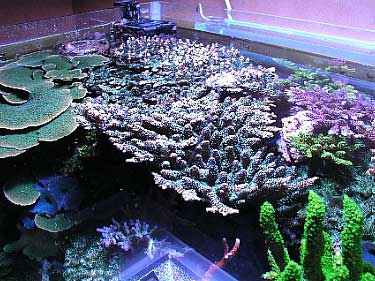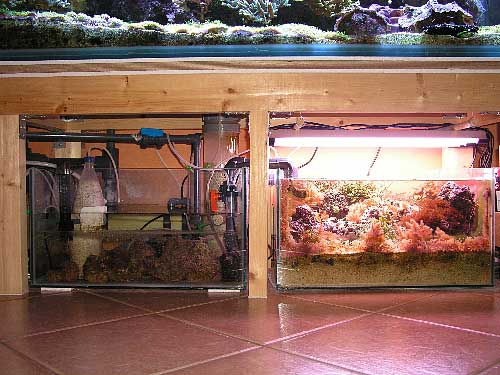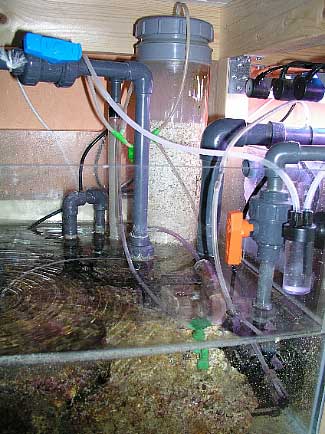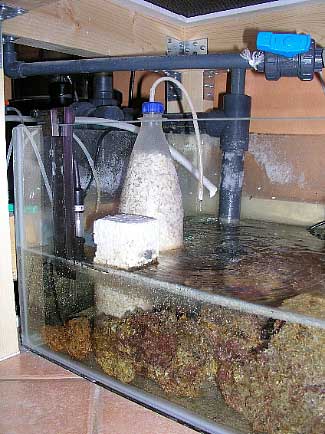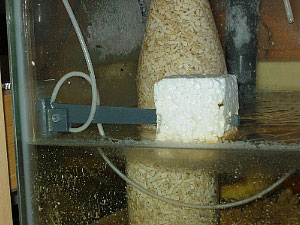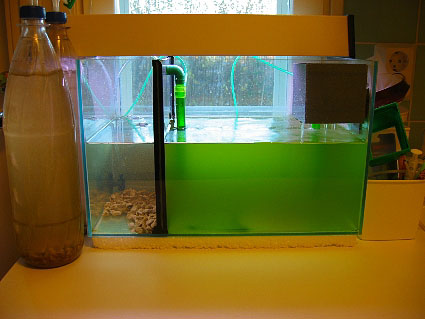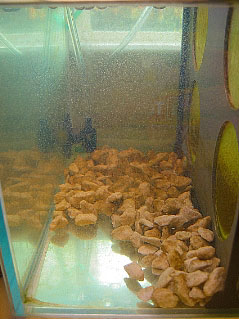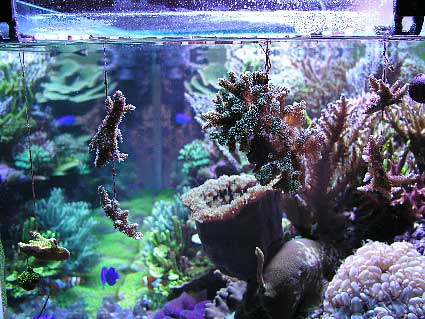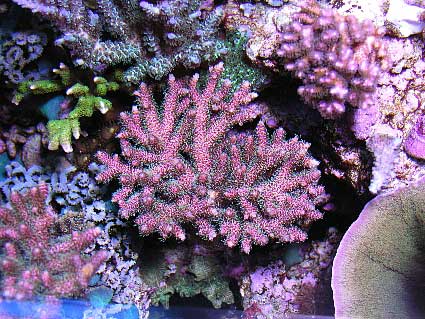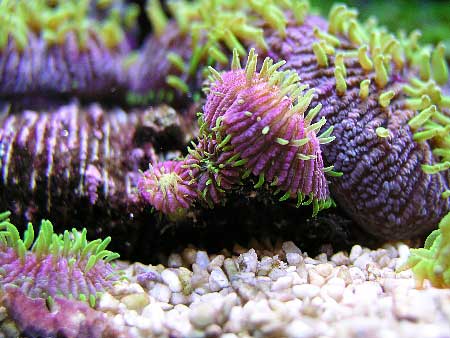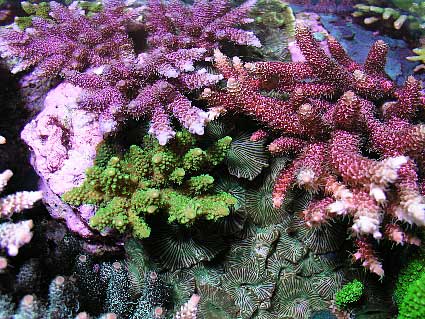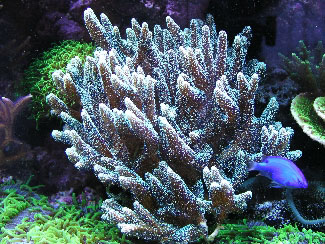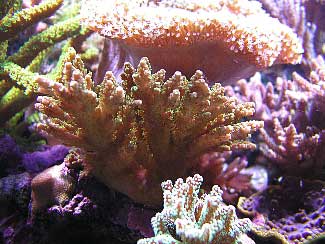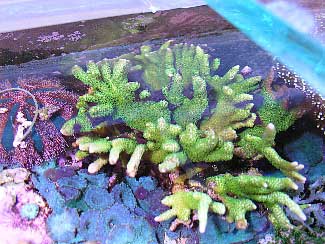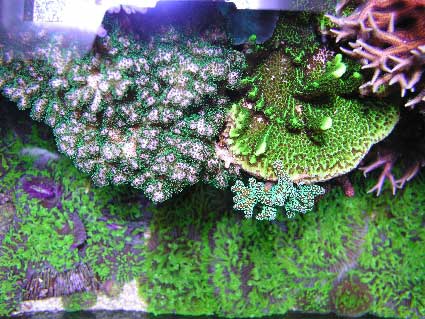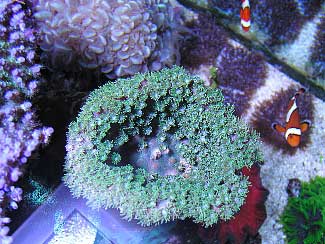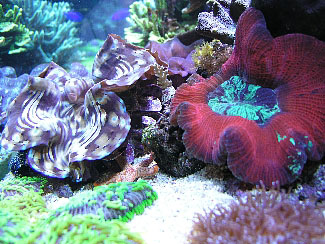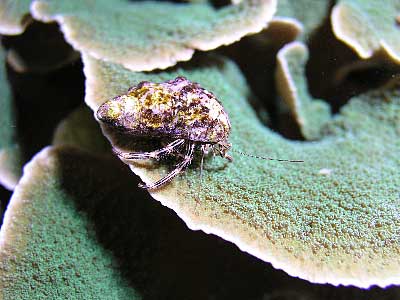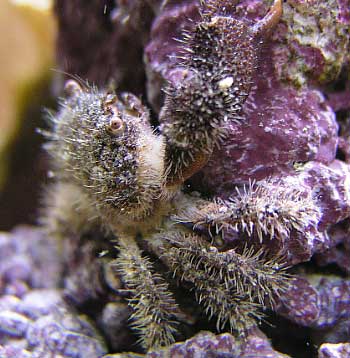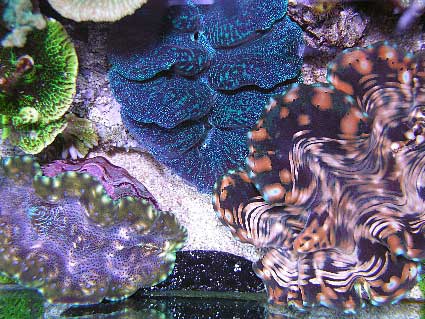Marko Haaga's (haaga) Reef Aquarium
History:
I have kept freshwater tanks since I
was about 10 years old. My first reef tank was set up in
1993. It was a small 36 gallon reef tank, which was built
almost completely by a "Do It Yourself" method.
I made the tank, protein skimmer, light canopy, fluorescent
light wiring, top-off doser and calcium reactor. Although
it was alot of hard work, the result was very satisfying.
My second reef was an 85 gallon tank with a sump, DIY skimmer,
Jaubert-style substrate with plenum, and eight 36 watt normal
output fluorescent tubes for lighting. This tank was very
successful. During the three years it was in operation,
I was able to observe several spawning events; one large
Acropora spawned twice, one Fungia several
times, and two Tridacna croceas also spawned several
times. Over the course of time, the fluorescent tubes were
replaced with metal halide lighting and the Jaubert style
plenum was removed. My current tank was set up in April
of 2002.
Being a reef aquarium enthusiast demands
a lot of patience and devotion, especially here in Finland.
It seems that here we are in a constant shortage of livestock.
This is due, at least in part, to the fact that our country
is situated in the northern hemisphere quite some distance
away from the main air traffic lines. This makes the animals
quite expensive. Also, the number of reefkeepers in our
country is quite low, so the demand for reef aquarium equipment
and livestock is quite low, and consequently the number
of dealers is also limited.
|
Aquarium Profile
|
•
|
110
gallon glass aquarium (55" x 22" x 22") |
|
•
|
19
gallon sump |
|
•
|
19
gallon refugium |
|
•
|
DIY
stand |
|
The Aquarium, Sump and Refugium:
The main tank is a 110 gallon all glass
aquarium. Under the tank there is a 19 gallon sump and a
19 gallon refugium. In the main tank, there is a one to
four inch sand bed consisting mainly of coral sand with
particles of 0.04 to 0.08 inch diameter. The refugium contains
four inches of coral sand of the same quality. Roughly 220
lbs. of live rock from Indonesia is used in the system,
most of which is in the main tank, but a little is also
in the sump and the refugium.
The water comes from the overflow of
the tank by gravity flow into the skimmer, and from there
the water flows to the sump. An Aquabee 2000/1 pump returns
the water to the main tank. From the sump the Aquabee 1000
pumps water to the refugium, and the water overflows back
into the sump near the main return pump. In the main tank
most of the water circulation is provided by Tunze 7210/2
and 7410/2 powerheads. Both an Aquabee 2000 and an Aquabee
1000 are used to pump water behind the live rock. The flow
rate through the pumps on the main tank is about 2300 gallons
per hour.
A close up of the refugium.
Lighting, Skimmer and Other Technology:
The lighting of the main tank consists
of a Giesemann "System 230 Plus" with two Aqua
Connect Performance 14000K 250 watt double-ended metal halide
bulbs, which are on for 10 hours a day. Additional lighting
comes from 2 x 24 watt Osram 67 blue power compact bulbs,
on for 14 hours a day. Prior to installing the 14000K bulbs,
I used Ushio 10000K bulbs, but the light was a bit too yellow
for my taste. The 14000K bulbs seem quite blue, and I suspect
the PAR reading is not as high as the Ushios. Therefore,
I think that in the future I will go back to the Ushios
and use more supplemental blue and actinic light. With respect
to the growth rate of the corals, I haven't noticed any
difference between these metal halide bulbs. The lighting
of the refugium is provided by four 18 watt normal output
fluorescent bulbs, two 10000K, one 6500K and one blue bulb.
The lights in the refugium are on for 16 hours at night
on a reverse daylight schedule.
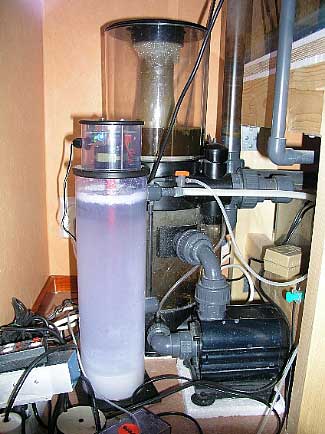 |
The protein skimmer is an Aqua Medic
Turboflotor 5000 Shorty Compact. It's an excellent needle-wheel
skimmer, and I'm very pleased with it. Although its' foam
production is quite minimal at present, this is highly dependent
on the feeding schedule for the fish and corals. The water
level in the sump is maintained by a very simple and reliable
DIY mechanical float
switch. Kalkwasser is used for all top-off water. Reverse
osmosis water runs through a Deltec KM500 kalkwasser reactor
and into the sump as a constant slow flow of drops. The
evaporation rate of the system is about one gallon per day.
The calcium reactor is a DIY two-stage reactor with adjustable
CO2 recirculation. The first calcium
reactor I made was from a Pepsi™ bottle; this new one
is a bit more elegant, but it also has a Pepsi™ bottle
as a second reactor chamber. The design is very simple but
effective.
The DIY float switch.
|
Water
Parameters
|
Specific Gravity: 1.025
|
|
Temp: 79 - 82ºF (In the
summer sometimes as high as 86ºF )
|
|
pH: 8.00 - 8.25 (Tunze 7070
pH controller)
|
|
Ca: 380 - 420 mg/l (Salifert)
|
|
Alk: 9 - 11 dKH (Sera)
|
|
Mg: 1400 mg/l (Salifert)
|
|
NO3:
0 mg/l (Sera)
|
|
PO4:
0 mg/l (Salifert)
|
|
I2:
0.06 mg/l (Salifert)
|
|
Sr: 4 mg/l (Salifert)
|
|
Maintenance:
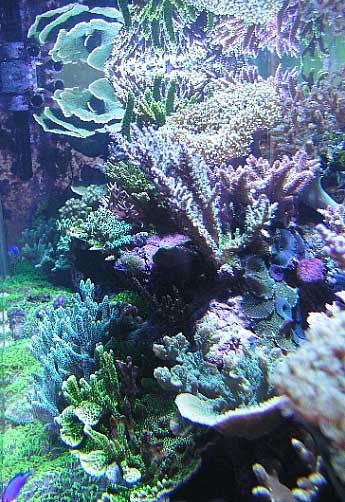 |
The glass of the main tank is cleaned
twice a week. A six-gallon water change is done every week.
The salt is mixed with RO water using Instant Ocean and
Tropic Marin salts, aerated for about one hour and then
added to the tank. The skimmer cup is cleaned about once
a week. Strontium and iron are added once a week and iodine
is added daily as Lugol's solution. Some time ago I didn't
use any of the previously mentioned additives. I then had
tissue sloughing in many of my Acropora colonies.
Upon checking the water parameters in the tank, everything
seemed fine, but the Sr and I2 were both zero according
to the Salifert test kits. I quickly raised these values
to normal seawater levels and the the sloughing stopped.
Of course, I don't know if Sr and I2
had any significant role in stopping the problem, but since
that event occurred, I have added them to keep their levels
within the range of normal seawater. I also add Salifert
Amino Coral weekly. The Caulerpa racemosa is thinned
about twice a month from the refugium.
At present I'm using nine ounces of Sera
activated carbon run continuously in the sump. The carbon
is replaced once a month. I'm also testing the passive use
of Rowaphos to determine if there are any beneficial effects
to my reef.
Feeding:
The tank is fed once a day. In my opinion,
the food amount given is not very high. I use mainly frozen
brine shrimp, Mysis and krill. Live phytoplankton
is given every day; live brine shrimp and live rotifers
are offered a couple of times per week. Occasionally, the
food is first soaked in GroTech VitAmino vitamin and aminoacid
solution for hour or two before usage. Every other night
H&S Marine de Luxe or AB Aqualine plancto coral food
is given.
The plankton reactor. Right: A close up of the zooplankton
compartment. In this reactor both phytoplankton and zooplankton
can be cultured. The small light spots in the water are
rotifers,
Brachionus plicatilis.
Phytoplankton and rotifers are cultured
in a Zinn
planktonreactor. It is an excellent product to cultivate
phyto- and zooplankton (Nannochloropsis sp. &
Brachionus plicatilis) with a minimal amount of work.
Once you set it up, it can function for up to a month or
two with very little maintenance. It has worked for me for
up to two months without any crash of the system. I now
clean the reactor once a month and start the cultures again.
I will never go back to the bottles again.
Inhabitants:
The tank is mainly dominated by SPS
corals including Acropora, Montipora and Pocillopora
species, but there are also a couple of soft corals. Many
of the corals are grown from fragments from my previous
tank, but I received many fragments from my fellow aquarists,
Tatu Vaajalahti and Aleksandr Pyndyk from Tampere, Finland.
A significant part of the tank is dominated
by a large Acropora colony, which I originally obtained
in 1995. Its original size was about 7 x 7 x 7 cm. Within
two years it had grown to the size of 35 x 35 x 20 cm. In
the late summer of 1997 (and also in 1998) I saw it releasing
small 1mm egg-sperm bundles.
The first spawning was mentioned by Alf
Jacob Nilsen in Aquarium
Frontiers and also in The Modern Coral Reef Aquarium,
Volume 2 and Volume 3. It was first believed to be Acropora
latistella, but my friend suggested that it is more
likely Acropora prostrata. Since the spawning this
coral has been fragmented several times. Tens of fragments
have been sold and given away, and even more have been thrown
away. Every two years I have been forced to break down the
whole colony because it has grown to the top of the aquarium
and shades the other corals. It is the fastest growing stony
coral I have ever owned.
Another interesting coral in my tank
is a Fungia which I also obtained in 1995. It is
a male since it has released sperm couple of times during
1997-1998. In 1999, it was shaded by the above mentioned
large Acropora for several months. During that period
part of the coral died. After fragmentation of the Acropora,
the Fungia was better illuminated and it began to
recover and produced small anthocauli. Each anthocaulus
detaches itself from the stalk and then a new anthocaulus
is produced. Over the course of three years tens of new
daughter polyps have been born, and this continues to this
day.
Other Corals:
|
Acropora sp. (11 species)
|
Porites
sp. (2 species)
|
|
Montipora sp. (5 species)
|
Seriatopora
sp. (3 species)
|
|
Pocillopora
sp. (2 species)
|
|
Caulastrea furcata
|
Hydnophora
|
|
Merulina
|
Plerogyra
sinuosa
|
|
Trachyphyllia geoffroyi
|
Turbinaria
peltata
|
|
Polyphyllia
talpina, fragmented from a large individual with
an axe.
|
|
Anthelia
|
Capnella,
many in the refugium
|
|
Clavularia viridis
|
Discosoma
spp.
|
|
Lopophytum
|
Sarcophyton
|
|
Sinularia flexibilis
|
Zoanthus
spp.
|
|
Amphiprion
ocellaris, a pair
|
Synchiropus
splendidus
|
|
Ctenochaetus strigosus
|
Zebrasoma
flavescens
|
|
Chrysiptera
cyanea, 2 males and 4 females
|
|
Astraea tectum snails
|
Tridacna
crocea
|
|
Tridacna derasa
|
Tridacna
squamosa
|
|
Many
other crabs and Alpheus shrimps from live rock
|
Lysmata
amboinensis,
2
|
|
Mespilia
globulus
|
Holothuria
atra
|
|
Hermit
crabs of species Calcinus laevimanus, Clinabanarius
spp. and Paguristes cadenati
|
|
Ophiarachna
incrassata, originally 2, but have reproduced
in the tank
|
You can visit my website
to see some more photos of my aquarium. You can also check
pictures of my first reef tank from 1995. Unfortunately,
the text in that section is in Finnish, which some of you
may find it a bit hard to understand. ;-)
Feel free to comment
or ask questions about my tank in the forum
for the online magazine.
|




